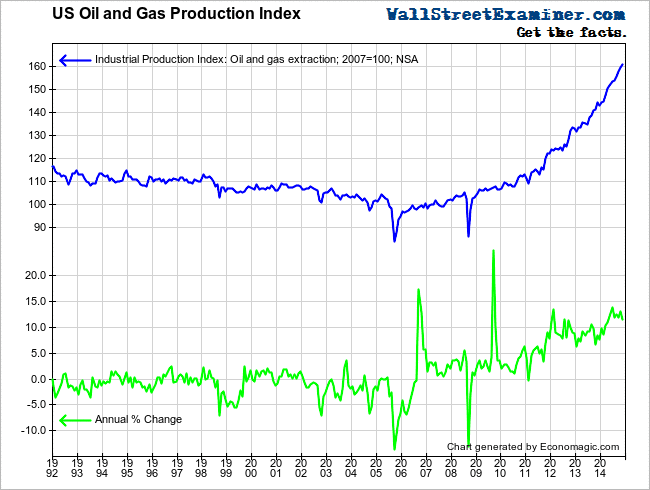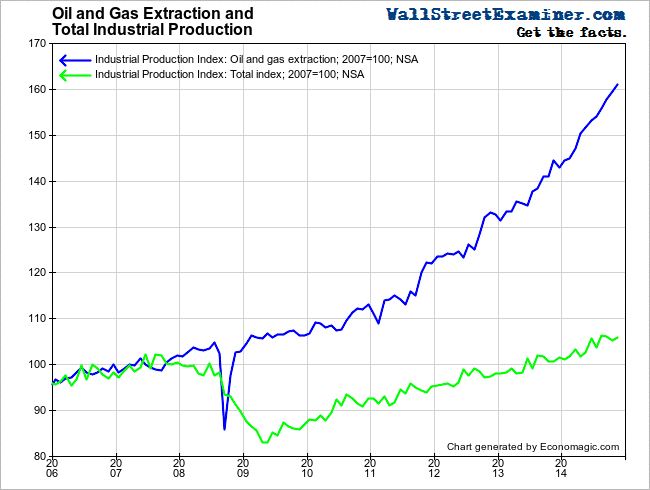The article below shows how important the shale oil boom has been to the US economy since 2009. It has accounted for a huge portion of employment and industrial production growth. The plunge in oil prices will bring this to an end, but it will be a two year relentless downturn as new investment dries up and the existing wells are depleted. We are in the Wile E Coyote phase of this wealth destruction. Gravity is a bitch.
The November industrial production data reported yesterday shows no slowdown yet in US oil and gas production, and as goes oil and gas, so goes the US economy.
The Oil and Gas Production Index for November rose by 1.55 points to 161.04 (2007= 100). This is one of the rare series where there’s no seasonality, so I need not rant about the media not reporting the actual, not seasonally adjusted data like I usually do. In fact, the media doesn’t even bother to report the oil and gas production component index of industrial production, so, sadly, there’s nobody to harangue. I miss it.
The year to year gain was 11.5%. That’s a bit of deceleration from the peak growth rate of 13.9% that was hit in June, but it’s still not too shabby. The oil and gas drilling boom/bubble–whatever you want to call it–was still raging last month while prices were already collapsing.
The question is how long this can go on.
It may take a while for production to be shut in. Exploration activity will slow but the drilling that has started but is not yet producing will continue to come on stream. That’s because the bulk of production costs are in finding oil. Once found, the lifting costs are very low. Where the oil has been found or almost found, the drilling and production will go on.
The US EIA said that lifting costs of US oil in 2007-09 were less than $13/BBL. Inflation might have added a bit to that since then, but one of the big component costs is energy, and that will obviously be lower now. Taxes will also be lower.
Under any circumstances, the current lifting costs are still a long way below current market prices even after the crash. So it’s likely that wells that are being drilled will continue to come on stream for a while longer. Due to the short productive life of fracked wells, existing production falls off quickly, but there’s no evidence that is having an impact yet.
The US oil boom should continue to contribute to the world wide oil glut for some months to come. While we may hear anecdotal reports of production shutdowns, the industrial production data should be the first hard data we get on that.
The oil and gas boom and its ripple effects throughout the entire energy and industrial complex have contributed mightily to overall US growth. Without the boom, US growth would look a lot more like the rest of the world, that is, moribund. Which leads to the questions, when the wells stop what happens to the US economy and…
What Becomes of the North Dakotans (with apologies to Jimmy Ruffin)
As I walk this field where I once grew beans,
I have visions of many things.
But the oil boom was just an illusion,
Trailed by bad debts and confusion.
What becomes of a broken market,
which had a boom that’s now departed?
I know we’re going to find,
A price where we can hold the line.
Maybe.
Drilling rigs grow all around
But for me they come a tumblin’ down.
Every day when the price goes much lower,
I want to stick my head in a snow blower!
I walk in shadows,
Searching for price lows.
Offers alone,
No buyers in sight.
Hoping and praying for someone who’ll cover,
Price is moving and goin’ lower.
(Refrain)
I’m searching though I don’t succeed,
For someone’s rigs, there’s a growing need.
All is lost, there’s no place for beginning,
All that’s left is an unhappy ending.
(Refrain)
I’ll be searching everywhere,
Just to find some gas to flare.
I’ll be looking everyday,
I know I’m gonna find a play.
Nothings gonna stop me now,
I don’t want no farm to plow.
I’ll be searching everywhere…
Get the facts. Follow Lee Adler’s chronicling of the market manipulating machinations of the Fed, Primary Dealers, the US Treasury, other central banks, and other key financial indicators of market direction in the Wall Street Examiner Professional Edition.
Try the Wall Street Examiner Professional Edition risk free for 30 days.
















